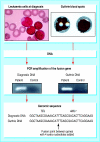Childhood leukaemia
- PMID: 11823363
- PMCID: PMC1122200
- DOI: 10.1136/bmj.324.7332.283
Childhood leukaemia
Figures





References
-
- Rowley JD. The critical role of chromosome translocations in human leukemias. Annu Rev Genet. 1998;32:495–519. - PubMed
-
- Kersey JH. Fifty years of studies of the biology and therapy of childhood leukemia. Blood. 1997;90:4243–4251. - PubMed
-
- Greaves M. Molecular genetics, natural history and the demise of childhood leukaemia. Eur J Cancer. 1999;35:173–185. - PubMed
-
- Greaves M. Cancer. The evolutionary legacy. Oxford: Oxford University Press; 2000.
-
- Ford AM, Ridge SA, Cabrera ME, Mahmoud H, Steel CM, Chan LC, et al. In utero rearrangements in the trithorax-related oncogene in infant leukaemias. Nature. 1993;363:358–360. - PubMed
Publication types
MeSH terms
Substances
LinkOut - more resources
Full Text Sources
Medical
